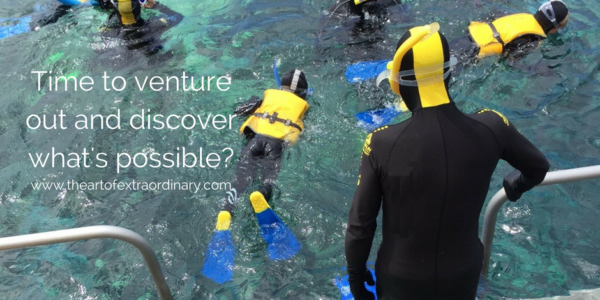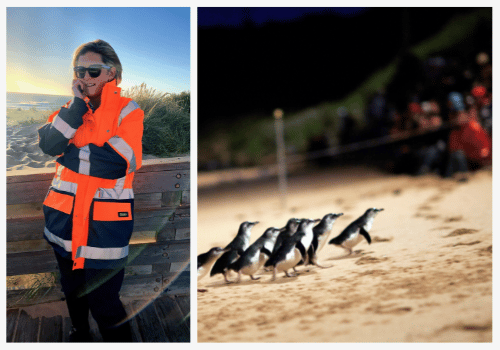
One family holiday we decided to brave it and all go snorkelling.
It seemed like a fairly mammoth effort getting everyone kitted out in wetsuits, snorkels, and fins. In the back of my mind, kept thinking, this would just be easier to stay on the boat, enjoy the views and the sounds of the waves lapping.
The fact that there seemed like close to another 300 other people also venturing into the water was a distinct deterrent as well. However foremost in my mind, was also a sense of curiosity. “I wonder if we’ll be able to do it? Will the kids enjoy it? Will we last 5 minutes or an hour? What will we see?”
Curiosity is by far one of life’s most underutilized and appreciated resources as have as leaders.
Too often the easier pathway is the one sort out. For many reasons, it’s safer, more comfortable, less risk, simply easier and it’s known.
The curiosity that day certainly got the better of me. So we all suited up, got organised and jumped into the water. I’ll never forget my 5-year-olds face, the ginormous eyes lit up behind the mask.
Her face actually almost barely visible beneath. However, she was off, feet flapping, maneuvering her way between many of those other 300 people. With husband and another child also in the water, we escaped the mayhem at the edge of the boat and ventured out.
This small hand reached out and we clasped hands, staying together exploring, kicking ourselves along, watching and signaling. Occasionally coming up for air, the most amusing moment, was said the 5-year-olds reaction to wearing a snorkel “Mummy, can I take this off now, I can’t talk with it on”.
Isn’t ignorance bliss?
So we kept snorkelling, stopping for air and discussion about the incredible sights, colours, and sounds. It’s amazing how the underwater world sounds so different too. We snorkelled for hours, right up until the limit of time, the crew had given us. We also ventured to the farthest point allowed, exploring every nook and cranny we could along the way. On returning to the boat, whilst pulling off the wetsuits, each child gobsmacked and in awe of what they’d seen and achieved. “It was so much fun”. And we, my husband and I, in awe of what we’d achieved.
Again, curiosity is one of life’s most underutilised and appreciated resources we have as a leader. Without it, we’d never had discovered what our family was capable of together. Neither would we have discovered what our children could do.
It’s so easy to put people into boxes of what they can and can’t do. What they’re capable of, without giving them a chance to venture out, explore, have a crack at new things or even do known or old things differently.
How are you with your team? Do you explore, venture out and experiment?
Or do you play it safe and stay with what’s known?
Do you encourage or discourage exploration or experimentation in the business, because by nature you’re more risk averse and like the certainty or the control?
Here’s are 3 steps we took to help us with the leap and dive into unknown waters.
- We presupposed they would be able to do it
Rather than focusing on what would happen if they couldn’t and wouldn’t want or be able to do it. We’re (and are always) careful and specific with the language that we used leading up to, during and after the process/event/activity/experience. And with that, we mean the language of communication including our words, our tone, and our body language.
- We matched their pace
It’s called pace, pace, lead. No rushing in and going too far / too fast. We explored and were curious with them without expecting that they would see or do things our way – even to the extent of allowing them to guide where we went and we would follow their cue and ask about what they were seeing. If you lead first (like a bull at a gate), it’s your pace, not theirs. And that may just be too far, too fast. So find the ideal pace.
- We made it fun.
Learning skills, new and old is so much more exciting when it’s fun. For some people getting out of their comfort zone can be perceived as scary and uncomfortable, some fear the unknown, doubt can be natural and is normal. We enabled them to stop, talk, share, laugh, express how they were feeling, take regular breaks and then pop their little heads down again into the amazing world beneath the water and continue exploring. Again, when new or different is required in the business environment, are you building in the fun factor, giving and receiving feedback, are you listening, asking questions? Are you encouraging or discouraging? Empowering or disempowering your team members?
The growth and learning for our family on this trip went way beyond the experience of using a snorkel and goggles. It’s never only about a technical skillset.
Each of us has enormous potential and in a team environment, it is so key to ensure we are respectful, curious and empowering of each and every individual to give and be their best version of themselves. For that to happen we need to understand and get where they are at, not expect, assume or judge where we think they ‘should’ be at, up to, what they can or cannot do yet. This is across the physical, technical, emotional and mental skills required and desired for a job role and for company culture.
It’s key to have benchmarks for performance in a business for a team to excel, how do you explore some of those less tangible attributes of confidence, ability to embrace uncertainty, take responsibility, curiosity, endurance, and tenacity?
The next time you are introducing someone to a new skill, updating an old skill, exploring what’s possible for a member of your team, curious about a ‘lack’ of skill, or checking in on performance levels, ask yourself:
- What am I presupposing here…? In order to do X do they have W, or do I believe they can do A so they can automatically do B, or because they haven’t done C yet, they won’t be able to do B. Confused…. great, so presuppose everyone can rather than can’t first always. Then explore…
- Am I pacing here? Check to ensure you are both running the 400-metre race and not someone the 100 meters and someone else is doing the half marathon. It is very easy to mismatch the pace with which we communicate, so check in that you’re pacing with the team. This includes if you’re communicating to various levels within a business. Match the pace. As a leader, you need to set and lead the pace…. however more on that another day.
- Make it fun. Serious, boring, tedious. No thank you. We all function much better when we have the endorphins flowing and a smile on our dial, so keep humour, lightness, and variety into how you teach, share, educate, lead and empower, no matter how serious the topic!!
Inside each and every one of us lies infinite potential.
Give your team the gift of discovery. Help unlock that potential.



